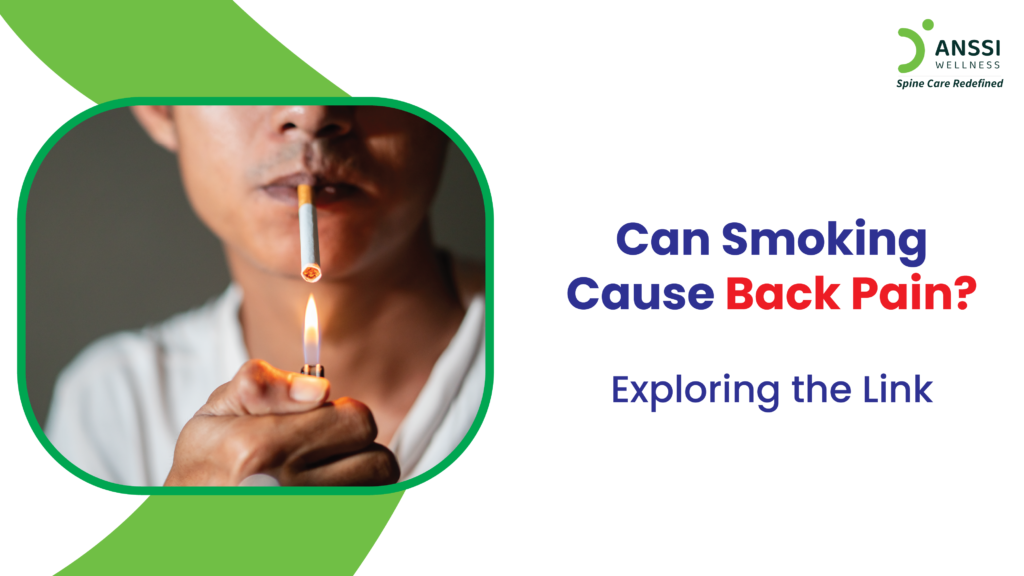When we think of the negative effects of smoking, most of us instantly think of lung disease, heart conditions, or even cancer. However, what often goes unnoticed is smoking’s impact on spinal health.
Surprising as it may sound, a growing body of research shows a strong link between smoking and chronic back pain. Here, we will explore how lighting up a cigarette could also be lighting up your spine with pain—and what you can do to find relief.
How Smoking Affects the Spine
The spine is a complex structure made up of vertebrae, intervertebral discs, muscles, and nerves. For it to function optimally, it needs a steady supply of nutrients and oxygen delivered through blood circulation. Smoking interferes with this essential process.
Nicotine in cigarettes narrows blood vessels, reducing blood flow throughout the body—including the spine. This limited circulation deprives spinal discs of oxygen and essential nutrients, which accelerates the degeneration of intervertebral discs. Over time, these discs dry out, lose their cushioning ability, and become more prone to injuries like herniation and bulging.
Reduced blood flow also hampers the healing process. When spinal tissues are injured—whether due to strain, wear-and-tear, or poor posture—they require adequate nutrients to repair themselves. Smoking limits this repair process, contributing to long-term damage and chronic pain.
Inflammation and Delayed Healing
Smoking also fuels inflammation in the body. It increases levels of inflammatory markers such as C-reactive protein (CRP), which heightens sensitivity in the nervous system and exacerbates chronic pain.
Moreover, carbon monoxide from cigarette smoke further reduces oxygen levels in the blood. This not only affects tissue repair but also prolongs recovery from existing injuries. As a result, smokers often take longer to heal from back injuries, leading to prolonged or recurrent episodes of pain.
Research and Evidence
Several studies have confirmed the correlation between smoking and back pain. A notable study published in the American Journal of Medicine found that current smokers were significantly more likely to experience chronic back pain than non-smokers or former smokers.
Another study published in Human Brain Mapping revealed that smokers who suffered from chronic back pain had altered brain responses in areas responsible for pain perception, suggesting that smoking might even rewire how the brain experiences pain.
Furthermore, research from the Spine Journal showed that smokers had higher rates of spinal disc degeneration and were more likely to require spinal surgeries.
Risk Factors and Compounding Issues
Smoking doesn’t just affect the spine directly; it also contributes to other lifestyle factors that may worsen back pain:
- Poor Posture: Smokers are more likely to lead sedentary lifestyles, which contributes to weak core muscles and poor spinal alignment.
- Chronic Cough: Constant coughing due to smoking puts repetitive strain on spinal muscles, increasing the risk of disc herniation and back pain.
- Weight Gain: Smoking is associated with unhealthy diets and decreased physical activity, which may result in weight gain—a key contributor to spinal stress.
- Reduced Bone Density: Long-term smoking can reduce calcium absorption and bone mineral density, increasing the risk of vertebral fractures and spinal instability.
So, if you’re dealing with back pain and also smoke, quitting smoking is one of the most effective first steps you can take.
Non-Invasive Treatments for Chronic Back Pain
Along with lifestyle changes, several non-invasive treatments can help manage or even relieve chronic spinal pain.
Over-the-Counter Pain Medications
NSAIDs like ibuprofen and acetaminophen can reduce inflammation and provide temporary pain relief. However, these should be used under guidance and not relied on for long-term use.
Gentle Exercise
Low-impact activities like walking, swimming, and yoga can help strengthen back muscles, improve flexibility, and reduce stiffness. Movement is essential for spinal health.
Hot and Cold Therapy
Applying a heating pad can improve blood flow and relax tense muscles. Cold packs, on the other hand, can reduce swelling and numb sharp pain.
Physical Therapy
A physical therapist can create a tailored exercise program to strengthen core muscles and improve posture. Techniques like manual therapy, dry needling, and guided stretching can offer long-term relief.
Non-Surgical Spinal Decompression Treatment
For those suffering from severe or persistent spinal pain—particularly due to disc degeneration or herniation—Non-Surgical Spinal Decompression Treatment is a breakthrough solution.
This treatment uses a motorised decompression table to gently stretch the spine in a controlled manner. The process creates negative pressure within the spinal discs, helping them retract and relieving pressure on nearby nerves. It also promotes the flow of oxygen, water, and nutrients into the discs—supporting natural healing.
Unlike surgery, non-surgical spinal decompression treatment is:
- Non-invasive
- Drug-free
- Painless
- Safe and effective for most patients
It’s never too late to take control of your spinal health. Quitting smoking, staying active, improving posture, and exploring non-invasive treatments can help you live a pain-free, healthier life.
About ANSSI:
ANSSI Wellness focuses on improving the quality of life for patients suffering from spinal issues, aiming to provide relief where other conventional treatments have failed. Through advanced non-surgical spinal decompression treatment, ANSSI is committed to helping patients avoid surgery and recover in a safe, effective, and compassionate environment.
Connect with ANSSI Wellness on LinkedIn, Instagram, and Facebook for expert guidance.



